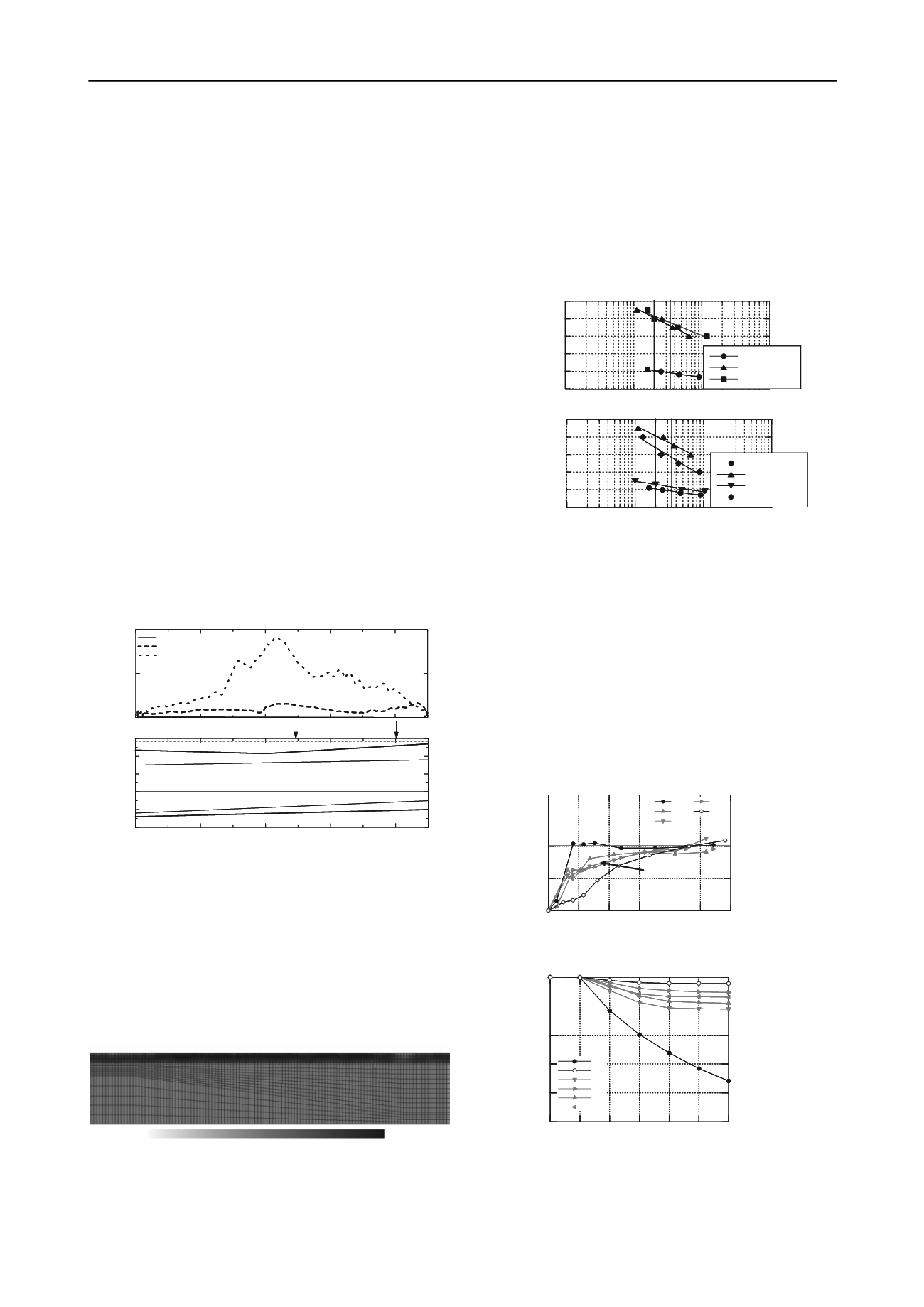
1403
Technical Committee 203 /
Comité technique 203
Province. The collapsible nature of such soils induced primarily
to revise both stress- and strain-based criteria for CTX tests,
adopting pore pressure ratio and strain thresholds more
conservative than usual; thereafter, the Chinese code of practice
rules for screening criteria and SPT-based method are amended.
Considering the lower penetration strength of such soils, the
reference SPT blowcount, N
0
, used for the evaluation of the
critical value, N
cr
, is reduced, in order to limit the degree of
conservativeness of the empirical method.
4.2
Field observations
Yasuda
(Japan) presents a comprehensive summary of ‘Soil
properties of liquefied soils in Tokyo Bay area by the 2011
Great East Japan earthquake’, aka Tohoku Earthquake
(M
w
=9.0), which induced widespread liquefaction of reclaimed
land. Cyclic TS tests with irregular loadings simulating the
mainshock and a short-term aftershock allowed to explain the
liquefaction of a silty sand in Urayasu City, which could not be
otherwise justified on the basis of the relatively low peak
ground acceleration, PGA, recorded (0.1-0.2g). Model tests on
the same soil loaded with concrete blocks simulating road
pavement could also show the mechanisms of sand eruption
under static hydraulic gradient. 2D seismic response analyses in
total stresses with significantly reduced stiffness for liquefied
soils were carried out to try explaining the unusual heaving,
buckling or thrust observed in some sites, which may have
followed post-liquefaction sloshing. The results suggested that
such phenomena might have occurred, due to the horizontal
compressive strain of liquefied ground (Fig. 14). In the writer’s
opinion, analyses with advanced constitutive modeling might be
helpful for a more objective interpretation.
0
0.5
1
G
0
was not reduced
G
0
was reduced to 1/50
G
0
was reduced to 1/100
Maximum strain(%)
0
200
400
600
800
0
10
20
30
40
50
distance(m)
Height(m)
F
(
Liquefied layer
)
Sand
Clay
Sand
Clay
Alluvial layer
A
A'
Diluvial layer
Thrust of a road
Figure 14. Seismic response analyses estimating the ground deformation
phenomena (
Yasuda
).
As a matter of fact, effective stress analyses were adopted
by
Asaoka & Nakai
(Japan) to interpret the phenomena occurred
in Urayasu City, referring to the ‘Dependency of non-uniform
ground surface liquefaction damage on organization and slope
of deep strata’. 1D and 2D coupled analyses with a hardening
plasticity constitutive model were carried out using field tests
data, focusing attention on the deep sloping clay deposits
underlying the liquefied ground. The results showed that low-
frequency amplification and localized shear strains might justify
the non-uniform liquefaction observed at surface (Fig. 15).
0.6
0.95
Figure 15. Predicted distribution of excess pore water pressure ratio
(
Asaoka & Nakai
).
4.3
Countermeasures
Following again the lessons learned from the aforementioned
Tohoku Earthquake,
Nakamichi & Sato
(Japan) investigate ‘A
method of suppressing liquefaction using a solidification
material and tension stiffeners’ by means of CTX tests on
Toyoura sand, prepared by wet tamping at D
r
=60%. The soil
was added with different contents of Portland cement (C) and
recycled Bassanite from waste plasterboard (B) as solidifying
materials, and PVA (polyvinyl alcohol) fibers with an average
length of 12.0 mm (F) as tension stiffener. Fig. 16 shows that
the cyclic strength is more than doubled by a 2% cement
addition and that a comparable improvement is obtained with
C=1% plus either 5% of Bassanite or 1% PVA fibers.
0.1
0.2
0.3
0.4
0.5
0.6
1
10
100
1000
C=0%
C=2%
C=1%+B=5%
Cyclic deviator
stress ratio
/p'
c
Number of cycles N (cycles)
20 34
0.1
0.2
0.3
0.4
0.5
0.6
1
10
100
1000
C=0%
C=2%
C=0%+F=1%
C=1%+F=1%
Cyclic deviator
stress ratio
/p'
c
Number of cycles N (cycles)
DA=5%
(a)
(b)
Figure 16. Cyclic strength of sand improved with different techniques
(
Nakamichi & Sato
).
H. Takahashi et al.
(Japan) present an ‘Experimental study
on lattice-shaped cement treatment method for liquefaction
countermeasure’, aimed to optimize the cost/effectiveness of
cement-treated piles by comparing the behaviour of fixed-type
and floating-type installations. These latter are not fixed to an
underlying un-liquefiable stratum and therefore expected to be
less effective. Pilot one-dimensional seismic response analyses
with or without lateral constraints in the treated soil highlighted
the basic confining mechanisms of the lattice-shaped grouting.
A comprehensive centrifuge testing program on two series of
models, consisting of floating-type grids without (A) and with
surrounding fixed-type treatments (B), permitted to verify the
increase of effectiveness with their depth in terms of reduction
of pore pressure buildup and surface settlements (Fig. 17).
1.5
1.0
0.5
0.0
Maximum E.P.W.P. (
u/
'
)
max
6 5 4 3 2 1 0
Acceleration (m/s
2
)
A1
A2
A3
A4
A5
1.0
0.8
0.6
0.4
0.2
0.0
Ground settlement (m)
6 5 4 3 2 1 0
Shaking step No.
B1
B2
B3
B4
B5
B6
(b)
(a)
unimproved
fixed-type
unimproved
fixed-type
floating-type
floating-type
Figure 17. Reduction of pore pressure buildup (a) and settlement (b) in
centrifuge tests on lattice-shaped treatments (
H. Takahashi et al.
).
N. Takahashi et al.
(Japan), instead, investigate on ‘Shaking
model tests on mitigation of liquefaction-induced ground flow
by new configuration of embedded columns’ again of grouted
soil. The performance of a regular triangular arrangement was


